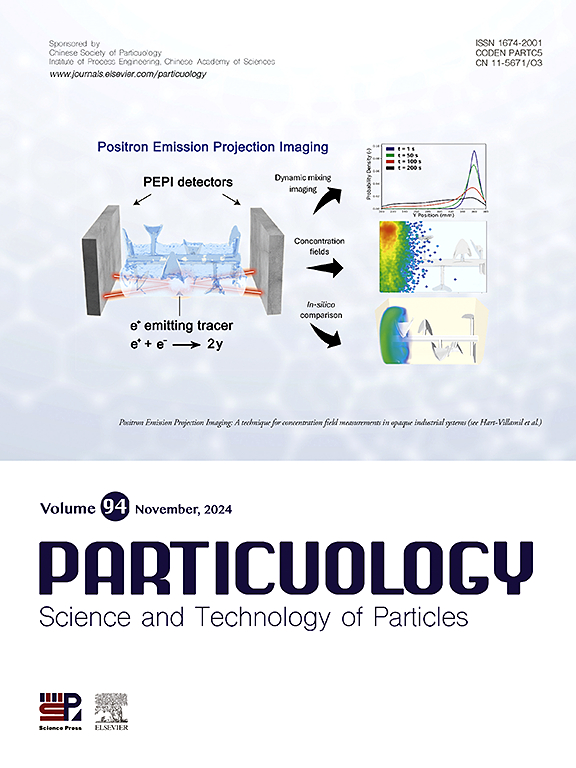Effect of co-incineration of sludge with MSW: Evolution characteristics of coarse ash particles and associated de novo synthesis of dioxin
IF 4.1
2区 材料科学
Q2 ENGINEERING, CHEMICAL
引用次数: 0
Abstract
This paper aims to report the evolution characteristics of the coarse ash particles generated from the co-incineration of municipal solid waste with other wastes, e.g. sewage sludge, to suggest suitable operational strategies to handle the side effects. By using an evolution model which addresses the mechanism of char combustion, volatile-induced fragmentation, and the transformation of included and excluded minerals particles, the coarse ash particle evolution process in the waste incinerator is successfully predicted. By comparing with in-situ measurement data of a 200 t/d forward grate MSW incinerator, the predicted total particle concentration is 275.7 mg/Nm3, and the relative difference is about 4.2 %. Although the variation in flue gas parameters has little effect on the distribution characteristics of coarse ash particles from municipal solid waste incineration (MSWI), the carbon content of coarse ash particles is more sensitive to flue parameter change. Due to the tight relationship between the PCDD/Fs and the carbon content of ash particles under the mechanism of the de novo synthesis, the increase in carbon concentration caused by the co-incineration of low-calorific value waste will increase the probability of the PCDD/Fs formation.

污泥与生活垃圾共焚烧的效果:粗灰颗粒演化特征及相关二恶英的重新合成
本文旨在报告城市固体废物与其他废物(如污水污泥)共同焚烧时产生的粗灰颗粒的演变特征,从而提出处理副作用的合适操作策略。通过使用一个演化模型,该模型解决了炭燃烧、挥发引起的破碎以及包含和排除矿物颗粒的转化等机制问题,成功预测了垃圾焚烧炉中粗灰颗粒的演化过程。通过与 200 吨/天正向炉排 MSW 焚烧炉的现场测量数据比较,预测的总颗粒浓度为 275.7 mg/Nm3,相对差值约为 4.2%。虽然烟气参数的变化对城市固体废物焚烧产生的粗灰颗粒的分布特征影响不大,但粗灰颗粒的含碳量对烟气参数的变化更为敏感。由于在从头合成机理下,多氯二苯并对二恶英和多氯二苯并呋喃与灰颗粒中的碳含量关系密切,低热值垃圾联合焚烧导致的碳浓度增加将增加多氯二苯并对二恶英和多氯二苯并呋喃形成的概率。
本文章由计算机程序翻译,如有差异,请以英文原文为准。
求助全文
约1分钟内获得全文
求助全文
来源期刊

Particuology
工程技术-材料科学:综合
CiteScore
6.70
自引率
2.90%
发文量
1730
审稿时长
32 days
期刊介绍:
The word ‘particuology’ was coined to parallel the discipline for the science and technology of particles.
Particuology is an interdisciplinary journal that publishes frontier research articles and critical reviews on the discovery, formulation and engineering of particulate materials, processes and systems. It especially welcomes contributions utilising advanced theoretical, modelling and measurement methods to enable the discovery and creation of new particulate materials, and the manufacturing of functional particulate-based products, such as sensors.
Papers are handled by Thematic Editors who oversee contributions from specific subject fields. These fields are classified into: Particle Synthesis and Modification; Particle Characterization and Measurement; Granular Systems and Bulk Solids Technology; Fluidization and Particle-Fluid Systems; Aerosols; and Applications of Particle Technology.
Key topics concerning the creation and processing of particulates include:
-Modelling and simulation of particle formation, collective behaviour of particles and systems for particle production over a broad spectrum of length scales
-Mining of experimental data for particle synthesis and surface properties to facilitate the creation of new materials and processes
-Particle design and preparation including controlled response and sensing functionalities in formation, delivery systems and biological systems, etc.
-Experimental and computational methods for visualization and analysis of particulate system.
These topics are broadly relevant to the production of materials, pharmaceuticals and food, and to the conversion of energy resources to fuels and protection of the environment.
 求助内容:
求助内容: 应助结果提醒方式:
应助结果提醒方式:


